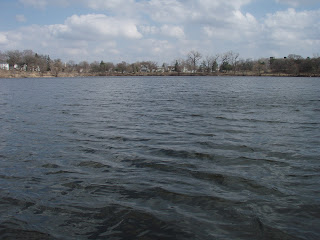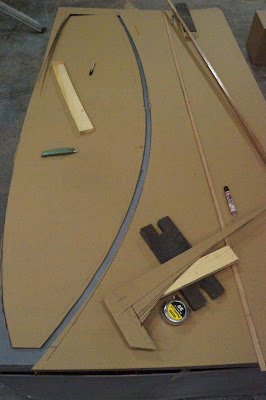Of late the skies have cleared and the strong winds have died down. Perfect boating weather! My first outing was Lake Como. It's kind of small, but close to my house and a good way to build those rowing muscles. The trouble is that all the warm weather has produced a banner crop of sea weed, also known around here as Eurasian Milfoil.
 |
| Blue skies over Lake Como: lovely weather! |
 |
| A banner crop of sea weed on Lake Como |
Rowing through this stuff is no party. It gets tangled up with the oar blades and winds itself around them. There is a way to deal with this. You can row with the blades not fully immersed. This way the weeds cannot wrap around the oars. If (when) the weeds get tangled, the trick is to leave the oar in the water and let the blades trail aft. The weeds will slide off the ends. In either case, progress is quickly be reduced to a crawl and rowing becomes no fun at all. Whatever the case may be, I decided to give up on Como for this summer.
 Tangled weeds on the oar blades |
My next attempt was Lake of the Isles. The park service regularly rakes the water with a special boat that removes the milfoil. The boat was out that day, but it soon became clear that they were having trouble keeping up with the problem. Weed had surrounded the launch point and collected along the northern shore.
Weeds along the Northern Shore of Lake of the Isles
But it was a lot better than Como and I was able to make my way to the channel connecting to Cedar Lake. I passed the rake boat and soon things got weedy again.
 |
| Rake boat removing sea weed from the channel |
I found still more weeds in Cedar Lake and gave up for the day. On the way home I passed under a couple of high school boys who were diving off a bridge. I snapped a couple pictures which you might enjoy.
 |
| Getting up the courage to jump |
And here he goes!
 |
| Breaking the water |
It's too bad that milfoil has found its way into out lakes. I guess it was bound to happen. The only way to prevent the spread is for everyone to clean their boat hulls after each outing. Maybe that's a lot to ask, but it's the only way. "Sky of blue sea of green" is taken from the Beatles' song. We all do live in a yellow submarine. The planet ecosystem is a closed system. Everything that we do seems to come full circle.
























.png)
